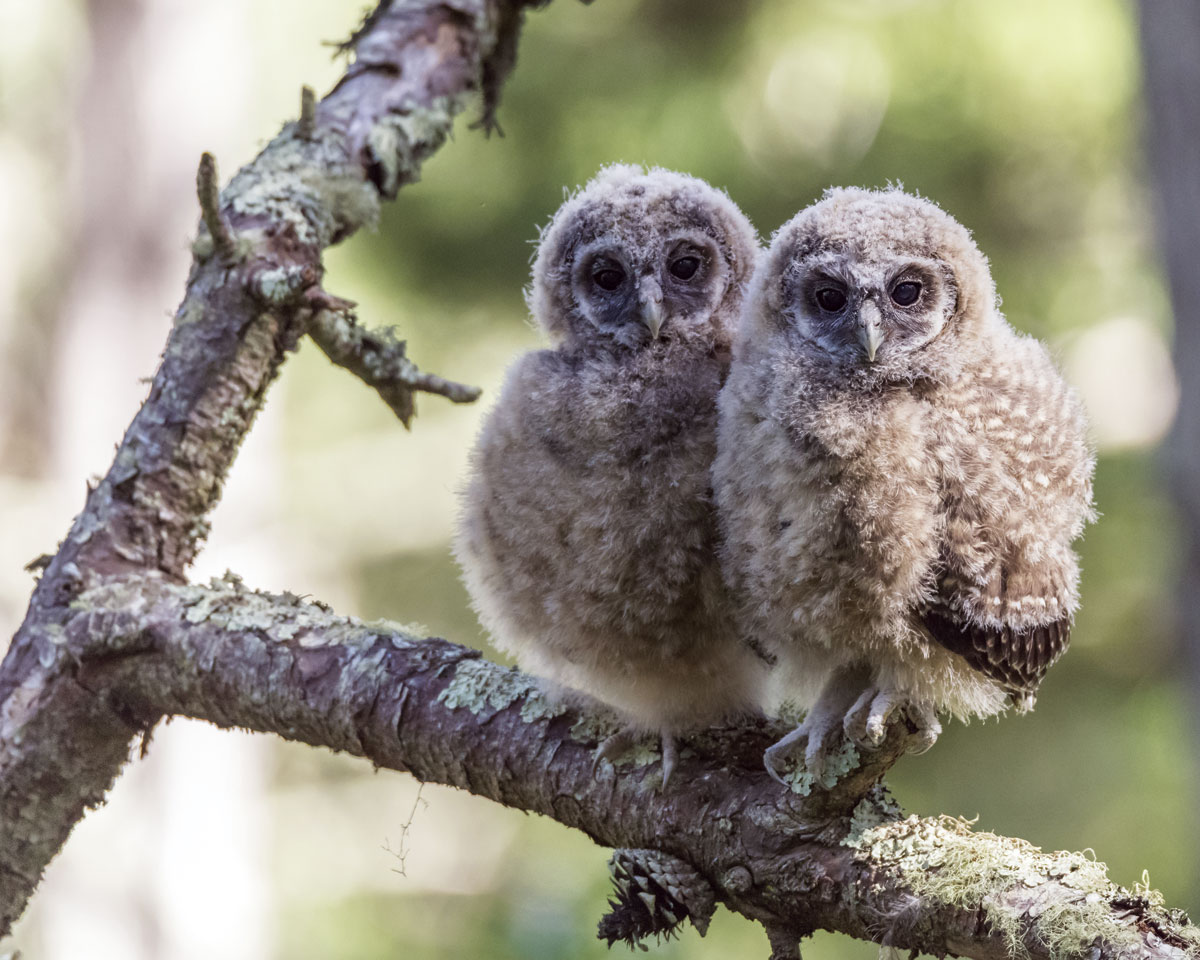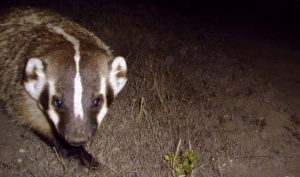It’s late on a mid-March afternoon when we enter the shadowy forest on the north slope of Mount Tamalpais. Earlier surveys here have located northern spotted owls, a territorial species that favors core areas of intact forest. We walk with caution, stepping over fallen branches, trying not to disturb the silence by breaking the brittle twigs, all the while looking upward toward the middle tiers of the forest canopy where an owl might roost. After crossing an unnamed runnel and sidestepping a woodrat lodge, we come to a dense family ring of redwoods. The trees here are not uniform and straight, but somewhat gnarly, with bole cavities, broken-topped snags, and flat-topped candelabras. Such mature many-layered gallery forests—with overlapping branches, nearly closed canopies, tangled understories, and vigorous living trees as well as decadent snags—are classic spotted owl habitat.
Remember, they are an exotic species in the Western United States, and are rapidly increasing their geographic range and range of habitats. Are they outcompeting or excluding native species in the process? How would we know? We have done almost nothing to monitor changes in the assemblage of mushroom species in areas before and and after the incursion of death caps.
Further Reading
Pringle et al, “The ectomycorrhizal fungus Amanita phalloides was introduced and is expanding its range on the west coast of North America,” Molecular Biology 2009
Lockhart et al, “Simultaneous emergence of multidrug-resistant Candida auris on 3 continents confirmed by whole-genome sequencing and epidemiological analyses,” Clinical Infectious Diseases 2017
Battalani et al, “Aflatoxin B1 contamination in maize in Europe increases due to climate change,” Scientific Reports 2016
Mount Tamalpais: A Mountain of Stories

A Mountain of Stories was produced by Bay Nature magazine with the generous support of the Tamalpais Lands Collaborative for publication in the October-December 2017 issue of the magazine. Read more stories from the mountain:
- Meet Mount Tamalpais, by John Hart
- Nature and Culture Mix in a Theatre Among the Oaks, by Claire Peaslee
- The Nature of the Dipsea Race, by Alisa Opar
- Alice Eastwood and the Plants of Tamalpais, by John Hart
- On the Hunt for Mount Tam’s Two Known Badgers, by Mary Ellen Hannibal
- Snorkel Surveys Reveal the World of Mount Tam’s Creeks, by Ariel Rubissow Okamoto
And there, next to the trunk of a massive tree, are two owls roosted side by side, still and silent, almost spectral. In the dappled light the birds’ coffee-brown feathering, speckled white, blends with the rusty bark. They appear to be aware of us observing them through our binoculars, but unconcerned, their dark, moon-shaped eyes reflecting the quintessential ancient spirit of the old growth forest.
These luxuriant forests of upper Lagunitas Creek, Phoenix Lake, and Bolinas Ridge are critical sanctuary for the northern spotted owl (Strix occidentalis caurina). A medium-size owl, perhaps the most emblematic animal of the Northwest’s temperate coastal forests, it is listed by both federal and state agencies as “threatened.”
The birds don’t migrate, commonly staying within the same home range year-round, rarely venturing far from the forest shadows. After forming a pair bond that may last a lifetime, a couple settles in a cryptic nest of sticks and lichen, often in the crotch or platform of branches of old growth redwoods and Douglas-fir, sometimes in live oaks and bays. In the early spring the female (slightly larger than the male) incubates a clutch commonly of one or two eggs, three when food is abundant. The male does most of the foraging and feeding of his mate for the four weeks of incubation. When they are about seven to nine days old, the downy young open their dark eyes. At about four weeks, the fluffy owlets are able to perch away from the nest (they’re sometimes called “branchers”), but still depend on their parents for food. Parents care for their offspring generally into September, when the young owls are finally able to forage for themselves and disperse in search of their own territory.
This reclusive owl is a nocturnal “perch-and-pounce” predator. Dusky-footed woodrats (Neotoma fuscipes) are a primary prey species here at the southern edge of the owl’s range, which extends north into British Columbia; flying squirrels (Glaucomys species) are the preferred prey farther north.

Over the last 200 years throughout the owl’s range, suitable habitat has been reduced by some 60 percent. Mount Tamalpais’ heterogeneous forest conditions, extensive protected habitat, and abundant prey, coupled with a relatively mild climate, provide a unique sanctuary. The forests of West Marin are separated from those of Sonoma County by unforested grasslands and all manner of human infrastructure. This relative isolation has limited the gene flow between the Marin population and more northerly populations, and research has shown these local birds occupy a somewhat broader habitat niche than those farther north.
Although Mount Tam’s sanctuary forests are relatively free from threats the owls face elsewhere, especially logging and extreme habitat modification, the owls here aren’t entirely “out of the woods” when it comes to survival. Mount Tam was identified as ground zero for Sudden Oak Death (SOD) in the mid-1990s and the disease has altered, and threatens to further alter, the structure of these forests. Tanoak (Notholithocarpus densiflorus) has been the primary victim of SOD, and its die-off has opened up the forests, creating a patchier and somewhat drier environment, not typically considered prime spotted owl habitat.
And there’s an invasive species on the scene that could pose another threat to the spotted owls of Mount Tam. The barred owl (Strix varia), which thrives more in “edge” habitats (although it has occupied dense forest fragments in the Pacific Northwest and Muir Woods), has expanded its range westward over the last half-century (or more) in response to landscape-level changes in the continent’s boreal forests, resulting in a breakdown of ecological barriers that formerly separated the two closely related species. Although the barred owl has usurped and displaced the spotted owl throughout much of the Pacific Northwest, the story in Marin is somewhat more encouraging.
Barred owls were first confirmed nesting in Marin in 2007, but so far they have not established a firm foothold here as they have in spotted owl territories farther north, and there have been no successful barred owl nests observed in Marin in more recent years. Exactly why is not yet clear to researchers, but they do confirm the status of these mixed conifer forests of Mount Tam as an important refuge for the spotted owl.
Intensive research, such as the surveys we’re conducting here for One Tam, has shown that in the watersheds around Mount Tam, the density of spotted owls is greater than elsewhere, reproductive success is relatively high, and a wider variety of habitats are used. Extensive protected public lands and the absence of logging are only part of the reason; in addition, other potential disturbances—recreational impacts, noise, urban encroachment, rodenticide use—have not been severe enough to cause population declines for this species, yet. Indeed, the 2017 breeding season was a productive one for the spotted owl, with 70 confirmed fledglings in Marin. So its population here appears to be stable, healthy, and sustainable, at least for the near future.
We watch as the daylight fades and the owls begin to stir. The male slowly stretches one of his wings, then swivels his round head toward his mate. Soon the male begins preening (grooming) the female and she lets out a quiet purr. After a few minutes she turns to face her mate and they begin a ritual of mutual bowing and cooing. Then, suddenly, he flies off but returns shortly with a headless woodrat that he presents to her. This food exchange will initiate the nesting cycle that, if successful, will result in the hatching and fledging of chicks.
Soon it’s getting too dark to see the owls, so we retrace our steps and leave them to their quiet hideaway, assured, at least for now, that they will survive and even thrive in their forested One Tam sanctuary.



